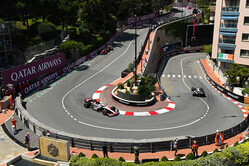


17/04/2024
NEWS STORY
 Red Bull's design guru, Adrian Newey admits that the 2026 regulations emphasis on power units will present he and his colleagues with a whole raft of challenges.
Red Bull's design guru, Adrian Newey admits that the 2026 regulations emphasis on power units will present he and his colleagues with a whole raft of challenges.
In a bid to encourage new manufacturers to the sport, the emphasis, from the outset, was to further increase the electrification side of the power unit, meaning that the battery and internal combustion engine will now both provide 50% of the power.
This in itself is likely to present a number of unique challenges.
"It's certainly going to be a strange formula in as much as the engines will be working flat-chat as generators just about the whole time," Newey told Autosport. "So, the prospect of the engine working hard in the middle of Loews hairpin is going to take some getting used to."
Meanwhile, in a bid to make up for the anticipated energy recovery deficit the sport is looking at active aero, though, as previously reported, this has resulted in a number of issues also.
Indeed, such was the determination to have the engine regulations neatly sewn up for those potential new manufacturers, with just weeks before the 2026 regulations need to be signed off, the sport is still seeking the means to finalise the chassis and aero regulations around them.
"I think that's fair comment," says Newey, "and probably one that even the FIA would acknowledge, that only the engine manufacturers wanted this kind of 50/50 combustion engine with electric.
"I guess it is what their marketing people said that we should be doing," he continues, "and I understand that. It's potentially interesting because F1 can be a fast-track developer of technology. However, the problem potentially on the battery and electric side is the cost currently, certainly of electric motors to F1 standard, plus inverters and batteries. It is very high, but perhaps production techniques in the future will help to bring that down.
"The other problem is the battery. What we need, or what the F1 regulations need out of the batteries in terms of power density and energy density, is quite different to what a normal road car needs. And that in itself means that the battery chemistry, and possibly battery construction is different. So, there's a risk that it won't be directly road-relevant.
"But perhaps that's not the key aspect anyway. The key aspect, certainly for the manufacturers although they will never admit it, is the perception of relevance in the showroom."
As for the aero, which has already resulted in a massive rethink in terms of the need for active aero elements at the front and rear of the cars, Newey admits: "I think it is going to be difficult.
"It is fair to say that the engine regulations were created and pushed through without very much thought to the chassis side of it, and that is now creating quite large problems in terms of trying to come up with a solution to work with it.
"But I think the one good thing out of that, is that it does promote efficiency. And I think anything that does that, and promotes that, has to be in line with what I said earlier, of trying to use F1 to popularise a trend."